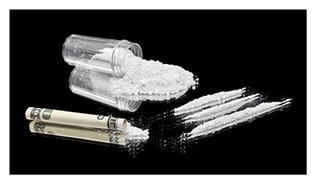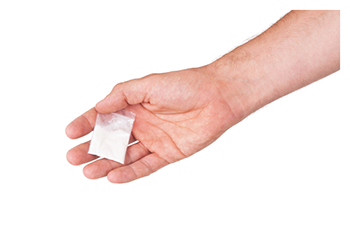Cocaine is a very powerful and a very popular stimulant. It is one of the most well-known illegal substances across Texas and the United States. It is a drug that cuts across social and economic strata and affects many kinds and types of people in our communities. Cocaine is hydrochloride salt when it is a powder, and crack is powdered cocaine combined with sodium bicarbonate and water. Cocaine stimulates the central nervous system. It can be snorted or rubbed into the gums, and it can also be smoked or injected. Crack cocaine is heated and smoked in a pipe. Cocaine can be also be freebased, which involves separating the cocaine from the salt hydrochloride. Freebasing is extremely dangerous because of the flammable chemicals involved. Cocaine operates in the human body by inhibiting the reuptake of the neurotransmitters serotonin and dopamine in the brain. This creates greater concentrations of serotonin and dopamine in the brain, and this induces feelings of euphoria. Other central nervous system effects are increased alertness, restlessness, insomnia, paranoia, and increased appetite.
Possession of Cocaine in Texas
According to Texas Law, cocaine is grouped with the substances that carry the most serious penalties. The penalties can vary drastically, and this depends on the amount. Cocaine is penalized in the Texas Controlled Substance Act. The law detailing the penalties is in the Texas Health and Safety Code. This page discusses the laws that prohibit and criminalize cocaine. It also outlines the penalties for possession of cocaine, identifies various other facets of possession of cocaine, and also discusses related crimes. Most importantly, this page discusses what steps to take if you or a loved one has been charged with a crime involving cocaine.
The Texas Controlled Substance Act
The Texas Controlled Substances Act is the body of law that identifies controlled substances, and criminalizes the possession and the distribution of illegal drugs. Drugs that have been deemed to be illegal fall into several types of drugs: narcotics, stimulants, depressants, hallucinogens, inhalants, and marijuana. Narcotics are substances like heroin and other opium-based substances and synthetic derivatives, and they are utilized to relieve pain. Depressants are prescription drugs like Xanax (Alprazolam) and Klonopin (Clonazepam) and other benzodiazepines and GHB. Depressants slow the central nervous system. Hallucinogens are substances like peyote (mescaline), DMT, and LSD that alter perception and thought. Stimulants speed up the central nervous system. As mentioned above, cocaine is a powerful stimulant. The substances are filed into five penalty groups that increase in severity of penalties from penalty group five (the lowest penalties) to penalty group one (the highest penalties). There are many controlled substances in Texas, and the entity in charge of determining into which group a substance is slotted is determined by the Texas commissioner of state health services. The determinations are made based on the potential for abuse, and the acknowledged medical value. Cocaine is a penalty group one substance, along with heroin and methamphetamine and others. Cocaine has been determined to have some medical value has a topical anesthetic for use in ENT, but the potential for abuse of cocaine is considered to be very high.
What is the Texas Law on Cocaine?
 Possession of cocaine is a felony, regardless of the amount. No matter how small of an amount there is, even a fractional quantity of weight, carries the potential for serious penalties. There are several categories of felonies with escalating ranges of punishment. Like all controlled substances, cocaine is weighed and penalized in terms of grams. Any amount under one gram is penalized as a state jail felony. This could be an amount as low as several hundredths of a gram. Depending on where the crime is prosecuted—which Texas County the arrest occurs—a District Attorneys’ Office could indict a case for one or two hundredths of a gram. In Tarrant County, generally any amount under two hundredths of a gram will not get filed, but in smaller counties such as Parker County, amounts such as .01 or lower are regularly filed and get indicted. The severity of enforcement can vary significantly when the county line is crossed. Larger counties are generally much more lenient than smaller counties, although even large counties prosecute possession of cocaine seriously. So much can depend on where the arrest happens. This goes not only for the way in which prosecutors pursue convictions or long deferred probations, but bond amount, bond conditions, and probation conditions can differ a great deal depending on where the soil that your standing is located.
Possession of cocaine is a felony, regardless of the amount. No matter how small of an amount there is, even a fractional quantity of weight, carries the potential for serious penalties. There are several categories of felonies with escalating ranges of punishment. Like all controlled substances, cocaine is weighed and penalized in terms of grams. Any amount under one gram is penalized as a state jail felony. This could be an amount as low as several hundredths of a gram. Depending on where the crime is prosecuted—which Texas County the arrest occurs—a District Attorneys’ Office could indict a case for one or two hundredths of a gram. In Tarrant County, generally any amount under two hundredths of a gram will not get filed, but in smaller counties such as Parker County, amounts such as .01 or lower are regularly filed and get indicted. The severity of enforcement can vary significantly when the county line is crossed. Larger counties are generally much more lenient than smaller counties, although even large counties prosecute possession of cocaine seriously. So much can depend on where the arrest happens. This goes not only for the way in which prosecutors pursue convictions or long deferred probations, but bond amount, bond conditions, and probation conditions can differ a great deal depending on where the soil that your standing is located.
What Does Possession Mean?
What does possession of cocaine mean? Does it mean having it on your, in your jacket or jeans pocket, in your house, or in your car? If someone leaves cocaine in your car, and you didn’t know that it is there, and you get pulled over, are you actually possessing it? The answer is that you are not legally possessing cocaine. However, the reality is that a police officer will assume that because it’s in your car, it is yours. You will likely get arrested and be in a position to defend a case and hire a lawyer. The crime of possession is defined in the Texas Penal Code in Section 1.07(39). The definition gives us four concepts: custody, care, management, and control. Having something in your control, or in your care, or managing something or having custody of a thing means to possess it. However, the statute says possession must be actual. There must be actual control, actual care, actual management, and actual custody. In the above example, if someone has cocaine in their car, police will often assume that they have custody or management of it, but that may not always be true. In the above example, it is not true. There is no possession. The bottom line is that actual possession is an element of the crime, and the state must prove beyond a reasonable doubt. A skilled criminal defense lawyer can take advantage of this in the right circumstances.
Possession of Crack Cocaine in Texas
Crack is also cocaine but clumped in rock structure instead of powdered. Crack is made by adding baking soda to cocaine. It is then boiled in water, creating a solid. The solid is broken into small chunks or rocks that is called crack cocaine. While powdered cocaine has a white or off-white appearance, crack is off-white or sometimes slightly yellow or tan in appearance. The appeal of crack is that it is cheaper than cocaine. Although possession of crack carries the same penalties as possession of powder cocaine does, the penalties can be substantially worse in practice. The reason for this is because of the other ingredients that are added to crack escalate the penalties. The possession penalties allow adulterants and dilutants to be weighed along with the cocaine, and they are not subtracted when the penalties are assessed by weight in grams. Adulterants and dilutants increase the volume. Adulterants and dilutants are usually present in powder cocaine as well in the form of cutting agents. Cutting agents can be glucose, sucrose, lactose, talc, boric acid, procaine, tetracaine, levamisole, strychnine, benzocaine, lidocaine, ephedrine, inositol, and Ritalin.
Possession of Cocaine is a Felony
 The penalties for possession of cocaine are set forth in section 481.115 of the Texas Health and Safety Code. As mentioned, possession of cocaine in any amount, is a felony in Texas. There are four degrees of felonies in Texas. Courts that have jurisdiction over felonies in Texas are District Courts and Criminal District Courts. More populated Texas Counties like Tarrant Counties have Criminal District Courts these court hear criminal cases exclusively. Smaller counties such as Parker County have general jurisdiction courts that hear felony criminal cases but If someone is convicted of a felony in Texas, it will stay there. The Texas legislature is allowing for more ways to seal record of conviction, and in 2017 allowed for the non-disclosure of a DWI conviction. However, as the law stands now, there is not a remedy for either expunging or sealing or non-disclosing the criminal record of arrest or conviction. If you receive a felony conviction for possession of cocaine, it will be an unremovable stain on your criminal record. Because of the seriousness and the weight that a felony conviction can bear on your future, it is very important to hire a criminal defense attorney to work on your case.
The penalties for possession of cocaine are set forth in section 481.115 of the Texas Health and Safety Code. As mentioned, possession of cocaine in any amount, is a felony in Texas. There are four degrees of felonies in Texas. Courts that have jurisdiction over felonies in Texas are District Courts and Criminal District Courts. More populated Texas Counties like Tarrant Counties have Criminal District Courts these court hear criminal cases exclusively. Smaller counties such as Parker County have general jurisdiction courts that hear felony criminal cases but If someone is convicted of a felony in Texas, it will stay there. The Texas legislature is allowing for more ways to seal record of conviction, and in 2017 allowed for the non-disclosure of a DWI conviction. However, as the law stands now, there is not a remedy for either expunging or sealing or non-disclosing the criminal record of arrest or conviction. If you receive a felony conviction for possession of cocaine, it will be an unremovable stain on your criminal record. Because of the seriousness and the weight that a felony conviction can bear on your future, it is very important to hire a criminal defense attorney to work on your case.
State Jail Felony Possession
When someone is arrested for possession of cocaine and the amount weighs under one gram, the charge will be a state jail felony. This is the most common charge for possession of cocaine for personal use. For possession with intent to distribute, there are usually larger amounts involved. State jail felony possession can mean between six months and two years in custody in a state jail facility, and up to a $10,000 fine. State jail facilities are separate and distinct from more severe felonies discussed below. State jail felony facilities are apart from Texas Department of Corrections, discussed below. For state jail felonies, probation is available. There are two kinds of probation, straight and deferred. Deferred probation is strongly preferred because if completed a conviction is avoided and the case is dismissed.
Third Degree Felony Possession
Possession of cocaine over one gram and less than four grams is a third-degree felony. When there is an amount of cocaine over a gram, it increases the penalty to the next level. The potential range of incarcerated time for a third-degree felony is between two years and ten years in the Texas Department of Corrections, and a fine capped at $10,000. The Texas Department of Corrections houses people with all felony convictions except state jail felonies. Probation is also available for third degree felonies. Both straight probation as well as deferred probation are available.
Second Degree Felony Possession
Possession of cocaine over four grams but under two hundred grams is a second-degree felony. The more cocaine that a person has, the more severe the penalties will be, obviously. When a person has over four grams, and especially if they have significantly over four grams, they may also be charged with possession with intent to distribute. The reason for this is because when there are large amounts of cocaine involved, law enforcement and district attorneys may begin to suspect that the person is also selling. A second-degree felony can mean between two and twenty years in the Texas Department of Corrections, and a fine capped at $10,000. Probation is available for second-degree felonies, and both straight probation and deferred are possible.
First Degree Felony Possession
Possession of an amount of cocaine more than two hundred grams but less than four hundred grams is a first-degree felony. More than two hundred grams is a very large amount of cocaine for personal use. Whether the charge will be possession or possession with intent to deliver will depend on the circumstances. How was the cocaine packaged? Was it located in one large container or several smaller containers that suggest an intent to sell or distribute? These are the circumstances that law enforcement and prosecutors will consider when determining what the charge will be. A first-degree felony can mean between five years and ninety-nine years in the Texas Department of Corrections. Probation is also available. Both straight probation and deferred probation are possible. However, probation is limited to a ten-year term.
How is Cocaine Tested?
How does a crime lab know that cocaine is actually cocaine? It may seem like a silly question, but when you start to think about it, how do they know what cocaine is and is not? The answer is that there is no way to know for sure without weighing the substance on a molecular level. There are many white powders in the world that could pass for cocaine. Laboratory analysts do not sit around and snort white powders and then notate how high they get. Neither do analysts rub white powders along their gums to test their physiological response. All joking aside, there are different kinds of tests to separate and distinguish cocaine from other substances that may resemble cocaine. Police have field tests that they can use pre-arrest to make a preliminary determination of cocaine. Field tests can provide probable cause for arrest, but these are only presumptive tests. Cobalt thiocyanate is a presumptive color test that turns bright blue when mixed with cocaine. Cobalt thiocyanate has been widely criticized for false positives. People have been convicted because of these false positives. Color tests like cobalt thiocyanate are insufficient due process to sustain a conviction. Cocaine must be tested in a laboratory using a confirmatory testing called mass spectrometry. The mass spectrometer is an incredible machine that breaks apart the molecules of a substance and weighs them to determine the molecular identity of a molecule. To confirm that something is cocaine to the exclusion of every other substance in the world, it must be weighed on the molecular level. One of the first things a skilled drug defense lawyer looks at is the report from the laboratory.
How Does a Conviction Impact Your Texas Driver’s License?
If getting a felony conviction were not enough punishment, a person will have their Texas driver’s license suspended automatically on final conviction of a drug offense. The law that allows this is section 521.372 of the Texas Transportation Code. The length of the driver’s license suspension is six months after the date of the drug conviction. If convicted, a person can obtain an occupational driver’s license that allows them to drive to work and for household needs.
Related Crime: Possession of Cocaine with Intent to Deliver
Possession with intent to deliver carries more substantial penalties than mere possession does. The only similarity is that both possession and possession with intent to deliver an amount of cocaine under one gram are both state jail felonies. The remaining penalties are all one degree higher. Possession with intent to deliver of an amount between one and four grams is a second-degree felony. Possession with an intent of an amount between four grams and two hundred grams is a first-degree felony. Any amount over four hundred grams has a punishment span between fifteen years and ninety-nine years. The reason why this highest category is so punitive is because this fifteen year minimum cuts off the possibility of probation, which is fixed at a maximum of ten years. To get the possibility of a probation on a charge of delivery over four hundred grams, the charge must be reduced to simple possession.
Delivery of Cocaine to a Person Under 18
There are enhanced penalties for delivery of cocaine to someone who is a child (meaning younger than 18 years old) and who is a student at either a primary or a secondary school. The penalties for this are on the second-degree felony level. This crime is set forth in section 481.122 of the Texas Health and Safety Code. The law states that it is an affirmative defense to a prosecution under this section if the person selling the cocaine is under 21 years old at the time the crime was committed and was not paid for it.









